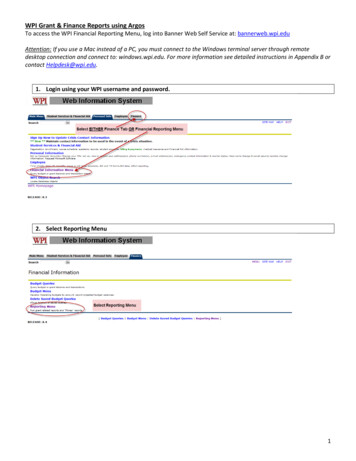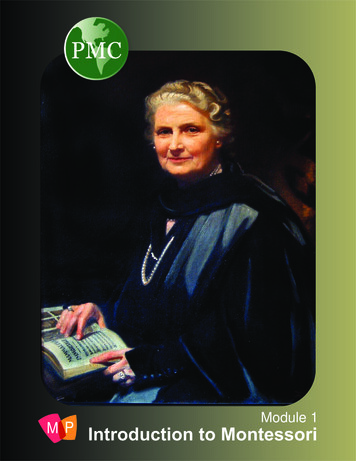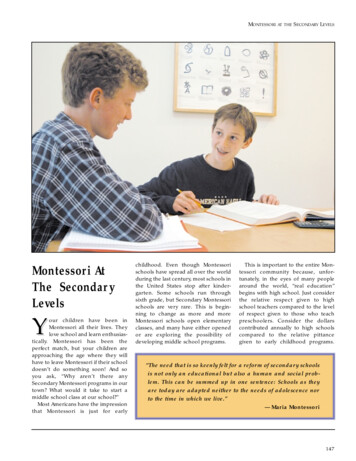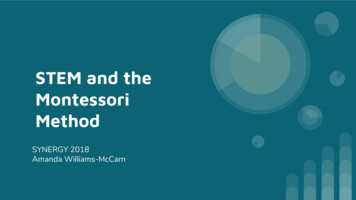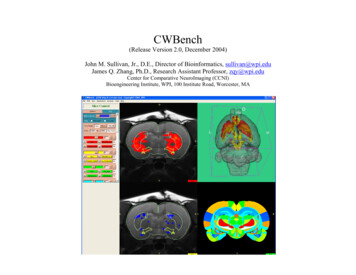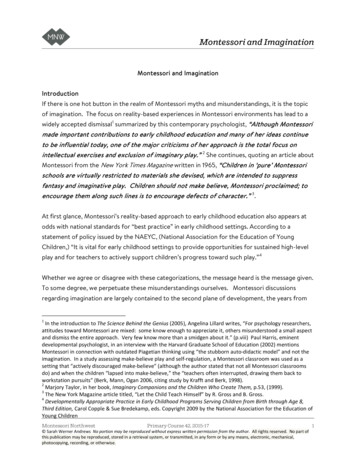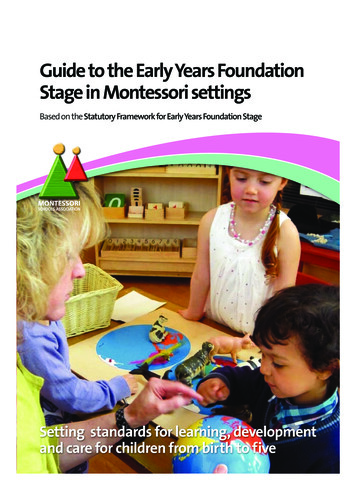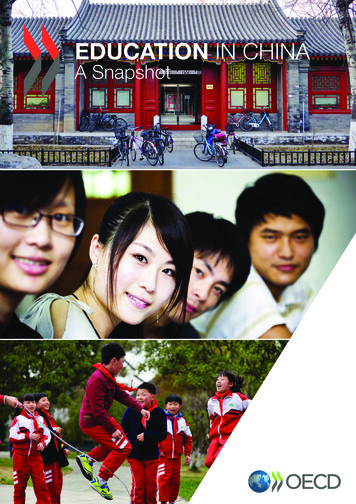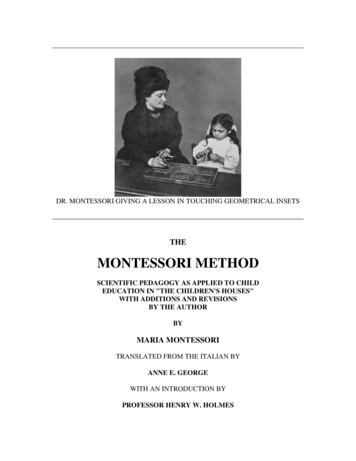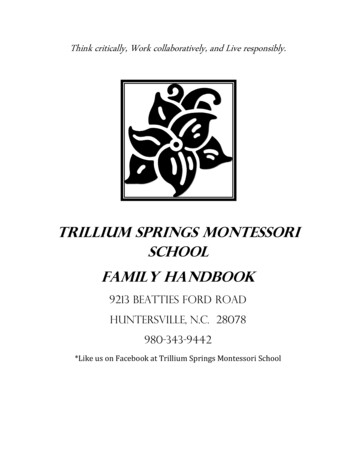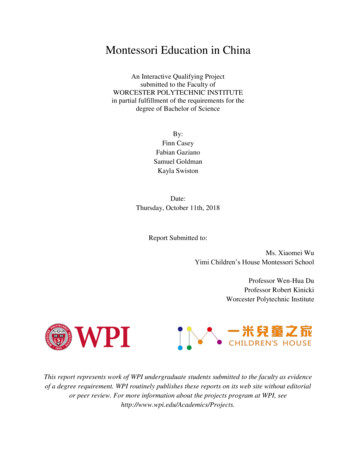
Transcription
Montessori Education in ChinaAn Interactive Qualifying Projectsubmitted to the Faculty ofWORCESTER POLYTECHNIC INSTITUTEin partial fulfillment of the requirements for thedegree of Bachelor of ScienceBy:Finn CaseyFabian GazianoSamuel GoldmanKayla SwistonDate:Thursday, October 11th, 2018Report Submitted to:Ms. Xiaomei WuYimi Children’s House Montessori SchoolProfessor Wen-Hua DuProfessor Robert KinickiWorcester Polytechnic InstituteThis report represents work of WPI undergraduate students submitted to the faculty as evidenceof a degree requirement. WPI routinely publishes these reports on its web site without editorialor peer review. For more information about the projects program at WPI, seehttp://www.wpi.edu/Academics/Projects.
Table of AuthorshipivTable of TablesvTable of FiguresviChapter 1: Introduction1Chapter 2: Background32.1 Montessori Education32.1.1 History of Montessori32.1.2 Montessori Principles and Methodology42.1.3 Montessori at Home72.2 Education in China82.2.1 Traditional Education in China82.2.2 Trends of Education in China92.2.3 Montessori Education in China2.3 Resources for Montessori Schools and Teachers10112.3.1 Association Montessori Internationale122.3.2 Training Effective Montessori Teachers132.4 Bilingual Education152.4.1 Typical Types of Bilingual Education162.4.2 Bilingual Education in China182.4.3 Montessori Bilingual Education192.5 一米兒童之家 (Yimi Children’s House)2.5.1 Stakeholders InvolvedChapter 3: Methodology3.1 Comparing Montessori Teaching Practices212224253.1.1 Interviewing Montessori Teachers and Administrators253.1.2 Evaluating Interview Results273.2 Determining Stakeholder Requirements283.2.1 Surveying Montessori Parents283.2.2 Conducting Stakeholder Focus Groups293.2.3 Evaluating Results from Parent Surveys and Focus Groups323.3 Recommending Best Practices333.3.1 Researching Case Studies343.3.2 Constructing Final Recommendations343.4 Project Timeline36ii P a g e
3.4.1 In Worcester363.4.2 In Hangzhou363.5 Data Management and Translation38Chapter 4: Conclusion39Bibliography40Appendix A: Teacher Interview Plan43Appendix B: Administrator Interview Plan45Appendix C: Teacher Focus Group Plan47Appendix D: Parent Survey Plan49Appendix E: Messages with Yimi Children’s House51iii P a g e
Table of lMontessori EducationKayla Swiston (primary)Samuel Goldman (editing)Montessori Education in ChinaFabian Gaziano (primary)Kayla Swiston (editing)Resources for Montessori Schools andTeachersFinn Casey (primary)Fabian Gaziano (editing)Bilingual EducationSamuel Goldman (primary)Finn Casey (editing)一米兒童之家 (Yimi Children’s House)Samuel Goldman (primary)Kayla Swiston, Finn Casey (editing)MethodologyAllComparing Montessori TeachingPracticesFinn Casey, Samuel Goldman (primary)Fabian Gaziano, Kayla Swiston (editing)Determining Stakeholder RequirementsFinn Casey, Fabian Gaziano (primary)Kayla Swiston (editing)Recommending Best PracticesSamuel Goldman (primary)Finn Casey (editing)Project TimelineKayla Swiston (primary)Samuel Goldman (editing)Data Management and TranslationSamuel Goldman (primary)Kayla Swiston (editing)ConclusionAlliv P a g e
Table of TablesTable 1: Selected Types of Bilingual Education16Table 2: Interview Topics26Table 3: Focus Group Questions31Table 4: Rubric for Evaluating Recommendations35Table 5: Anticipated Montessori Project Gantt Chart (Worcester)36Table 6: Anticipated Project Gantt Chart (Hangzhou)37v Page
Table of FiguresFigure 1: The Yimi Children’s Home’s kitchen5Figure 2: Open space for children to do their “work”5Figure 3: Image of the Children’s House21Figure 4: Progression of Project Objectives24vi P a g e
Executive SummaryIn order to train and improve the quality of their teachers, the Yimi Children’s Housewants to send them abroad. This plan includes enrolling teachers in official AssociationMontessori Internationale courses. Additionally, Yimi wants their teachers to gain first handteaching experience in the United States and learn Western standards of Montessori education.Thus, Yimi seeks to establish a teacher exchange program with Montessori schools.Yimi wants a series of recommendations to best implement a teacher exchange program.In order to accomplish this, the team identified three main objectives. First, the team willevaluate the areas in which teachers can learn when they teach abroad. To determine if enough ofa difference in Montessori practices exists between the US and China, the team willcompare interview responses from Montessori teachers and administrators in each country.Second, the team will proceed by determining which opportunities align with the needs ofthe three main stakeholder groups: teachers, administrators, and parents. The team will surveyparents and conduct focus group studies with teachers and administrators, combining these withthe results from the interviews to determine where there is overlap.Finally, the team will construct recommendations for how the sponsor should implementan exchange program to best take advantage of the opportunities previously identified. However,this project will not reinvent the wheel. Instead, the team will study various established teacherexchange programs, Montessori or otherwise, and attempt to find correlation between successfulaspects of each and the specific goal of each program. The team will then adapt variouscomponents into recommendations for a program that best suits the program.vii P a g e
Chapter 1: IntroductionIn 2015, the Chinese Communist Party (CCP) voted to remove China’s long standingone-child policy, effective January 2016. Now that Chinese parents may have more than onechild, one of the more immediate concerns involves the need for more educational capacity —first at the kindergarten level and eventually beyond (Xinhua Economic News, 2015).Additionally, at the turn of the millennium, China launched large-scale education reform,embracing several Western curriculum models including the Montessori education methodology(Li, Wang, & Wong, 2011). These changes to Chinese society and educational practices provideample opportunity for this project’s sponsor, a Montessori school named the Yimi Children’sHouse, to expand its capacity and curriculum.一米兒童之家, The Yimi (Yīmǐ) Children’s House in Hangzhou, opened its doors in2012 and currently teaches nearly 200 students. One of Yimi’s main struggles revolves aroundthe availability of the specially trained teachers that the Montessori method requires. Currently,the school employs over 50 teachers and anticipates hiring nearly 50 more in the next year toaccommodate an estimated enrolment of 400 students in 2019, thus growing to meet the needs ofits expanding community. The school planned on opening an English-Chinese bilingualMontessori program in the fall of 2018, but these plans fell through due to the lack of adequatelytrained teachers. As a result, the Yimi Children’s House seeks to hire and train new teachers toaccommodate the demands of their rapidly expanding school.Administrators at Yimi aspire to send some of their teachers to the United States as partof a teacher exchange program with American Montessori schools. Ideally such a program would1 Page
provide more extensive training opportunities for Yimi teachers and perhaps even attract newteachers to the school. Furthermore, providing education training for teachers outside of theirnative country offers them with a more versatile and well-rounded background, especially whenconsidering the cultural differences between China and the West. Administrators see theexchange program as a way to extend its practice of sending teachers abroad to receive officialtraining via the Association Montessori Internationale (AMI).Other than Yimi and their fellow Montessori schools in China sending their teachersabroad for course-based training, few examples of Montessori teacher exchange programs exist.This leaves Yimi with few resources to use in establishing their program as envisioned. Whileexchange programs specific to Montessori schools may not exist to provide insight, otherexchange programs do exist. Between 1996 and 2014 the U.S.-China Teachers ExchangeProgram sent 117 American teachers to teach in China and 332 Chinese teachers to the UnitedStates (National Committee on U.S.-China Relations, 2014). This program, and others like it,provide a starting point from which this project can develop its final recommendations.To assist Yimi in their goal of establishing an exchange program, this project will firstwork to determine how stakeholders involved would benefit from this program. By interviewingteachers in both the United States and China as well as conducting focus groups and surveyingparents, this project will determine the areas in which teachers would learn the most fromteaching in their counterpart’s school abroad. From these interviews, the team will makerecommendations to the Yimi Children’s House in regards to how to implement such anexchange program in such a way that the program meets all stakeholder requirements and goals.2 Page
Chapter 2: BackgroundThis chapter discusses the principles that comprise Montessori education, how suchmethods are adopted in China, and how educators integrate bilingual learning into Montessorieducation. Additionally, it covers the international and country-specific organizations thatoversee and provide support for Montessori schools worldwide. The purpose of researching thesetopics is to gain a reasonable understanding of Montessori education and its internationalpresence in order to produce well-rounded recommendations for establishingobservations/exchange programs between Children’s House and United States schools.2.1 Montessori EducationInitially developed by Dr. Maria Montessori (Zoll, 2017), the Montessori method ofeducation intends to redefine pedagogy by encouraging a hands-off approach and letting thenatural curiosity of children guide their experience. This method extends beyond just the schoolenvironment, as parents and caretakers play an important role in applying the method at home(Lau & Yau, 2015). While this project aims to encompass Montessori teacher exchange, thissection serves to provide insight into the concept of a Montessori school, and how thisphilosophy differs from traditional teaching methodology.2.1.1 History of MontessoriIn an effort to revolutionize the educational methodology for teaching young children,Dr. Montessori introduced the Montessori method in the early 20th century. The introduction ofthis education method came in four waves. The first wave of Montessori implementation beganbetween 1911 and 1917, with Maria Montessori’s first International Training Course and the3 Page
establishment of over 100 Montessori schools throughout the United States (Zoll, 2017). In hertraining course, Dr. Montessori explained her theory of the unique development of the youngmind, such that there is a potential to learn and develop without the assistance of traditionalteaching tools or methods, additionally stressing the importance of adult guidance during thedevelopment process. The stress on adult guidance aims more toward “when education becomesa ‘help to life’ and transcends the narrow limits of teaching and direct transmission of knowledgeor ideals from one mind to another,” rather than traditional pre-determined class sessions(Montessori, 1967, pg. 1).The second wave of implementation took place between 1960 and 1975, the era ofalternative education. This wave was a revival of the Montessori method led by NancyRambusch. The year 1975 ushered in the third wave of Montessori education. This wave, whichlasted until 1989, focused on poverty mitigation and developing Montessori magnet schools.Finally, the fourth wave began in 1990 and continues through the present day. This waveencompasses the expansion of Montessori philosophy into public schools, charters, and otherdelivery models. With each revival of the Montessori philosophy, implementation challengesarose in the United States as a result of shifts in education policy, failed professionalrelationships, politics, and funding issues, making it difficult for mainstream education to adoptMontessori education practices (Zoll, 2017).2.1.2 Montessori Principles and MethodologyThe principles of the Montessori method differ greatly from traditional schoolingmethods across the world. Montessori schools typically bear the name “Children’s House”, asthe environment of such a school ideally becomes a life-sized doll house for the children to4 Page
explore and “seeks to give all this to the child in reality––making him an actor in a living scene”(Montessori, 1914, pg. 17). A very prominent principle sets a standard for how Children’s Houseprepares their environment (Montessori, 1967). To accommodate the children, furniture must belight enough for children to move around, and of a suitable height; Figure 2 depicts a functionalkitchen from the Yimi Children’s House, designed for the smaller hands of children. Mostimportantly, children must have a wide open area in which to lay down their rugs on which theydo their “work”; they bring any object they are experimenting with to their rug and do “work” onit. This large open area necessitates that Montessori classrooms be larger than traditionalclassrooms (Montessori, 1914), as shown in Figure 2.Figure 1: The Yimi Children’s Home’s kitchen(Source: Yimi Children’s House)Figure 2: Open space for children to do their “work”(Source: Yimi Children’s House)Another core principle provides guidance for teacher intervention in the classroom.Collective lessons are very rare and of secondary importance to the freedom of the children toguide their own education. A teacher does not merely observe the children, but must additionallyteach individualized lessons through experimentation, varying child to child. These lessons havethree characteristics — they must be concise, so the teachers must carefully weigh the wordsthey choose to speak; they must be simple, so it is easy to understand and refer to nothing but thetruth; they must be objective, in that the personality of the teacher is not present, and the onlything holding the child’s attention is the object to be explained and the potential uses for theobject. It is vital to this process that the teacher first observe the interest of the child in the object,5 Page
and then attempt to apply a lesson. They must not insist the child understand by repeating thelesson, nor make the child feel they have made a mistake, else the child does not reachunderstanding and acceptance through a natural process (Montessori, 1912).Lessons apply to any aspect of the methodology, and the methodology of a Montessorischool falls into any of three categories: motor education, sensory education and language.Motor education aims to bring order to the seemingly never-ending movement of small childrenand guide it to a purpose. Young children do not keep still because it is in their nature to toucheverything and move around in order to learn the necessary control over their motor skills andcoordination. Exercises such as gymnastics, gardening, management of the household, self-care,everyday movements such as walking or running, and manual work bring order to the developingmotions of the children (Montessori, 1914). One such motor education method makes use ofseveral portable boards or frames with various cloths to tie, button and zip together. Once a childhas learned how the mechanism works, they will excitedly go about applying the skills to theirown clothing, insisting to the point of waving away adults seeking to help (Montessori, 1912).For sensory education, the process remains mostly the same, though the objects ofinterest are slightly different. The school carefully chooses these objects for their varioustextures, sizes and shapes, as well as the sounds they are capable of making. For language, thecurriculum breaks the methodology into three steps — naming, where the teacher says the wordto be taught, such as “large” or “small”; recognition, where the teacher asks the child a series ofrepetitive questions to reinforce the application of the new word; and pronunciation, where theteacher prompts the child to say the new word or phrase (Montessori, 1914). In this scheme, thechild may draw their own conclusions about the meaning of the word based on their own6 Page
observations of the object instead of being told to accept such a meaning whether theyunderstand the basic concept or not.2.1.3 Montessori at HomeAs important as it is to learn how to learn at school, the environment of learning providedat home is, in some manners, just as important. To receive the full benefits of a Montessorieducation, studies (Lau & Yau, 2015) show that children receive greater benefits fromMontessori education when their home mirrors the environment and processes of their school. Inthe early developmental stage of children, they are exposed to and absorb information primarilyfrom their parents or other primary caregivers, making those adults arguably the most importanteducators for young children. When these parents or caregivers do not properly understand thedevelopmental needs of their children, it hinders the child’s awareness, perceptions andunderstanding of their own motor controls. To help alleviate this issue, there are parentalMontessori programs for caregivers to enroll in and learn about the process and how to apply itto everyday life with their children. Over eight years, according to collected surveys by over16,000 parents who have taken parental Montessori classes in Hong Kong and mainland China,“almost all of them have indicated that the Montessori parent program has positively changedtheir attitudes toward their children and affected the way they live. Many said they had madeimprovements in terms of their sensorial, observational, and expressive abilities after the classes”(Lau & Yau, 2015, pg. 37). This statistic shows the importance of parents providing aMontessori environment outside of school and the positive impact it has on the children’seducation.7 Page
2.2 Education in ChinaApplying plans such as Montessori parent programs to Chinese parents and studentspresents unique issues. Even though Montessori schools are growing in popularity, the Chineseschooling method and Montessori method conflict in terms of tradition and reform priority. Forinstance, the respect for elders and authority conflicts with an equalized form of communication,and “the traditional values of obeying authorities and upholding unity are contrary to the goal ofestablishing a unique and democratic relationship between a teacher and each individual child”(Zhu & Zhang 2008, pg. 175). Furthermore, educational reform implemented changes around theturn of the century, but these reform policies have not been given priority due to culturaldifferences. Therefore, the Montessori method provides a highly contrasting approach toeducation for Chinese students that is otherwise unavailable.2.2.1 Traditional Education in ChinaChina’s extensive history and unique culture play large roles in defining its educationalsystem today. The history of Chinese education follows many of the same principles outlined byConfucianism:1. Society consists of a system interrelated parts.2. To function well, these parts need to be in harmony with one another.3. Anything out of the ordinary leads to strife and sub‐optimal functioning.4. Should unusual events take place, the system immediately strives to return to itsformer equilibrium. (Schmidtke & Peng, 2012)Education guided by these principles aims to create a harmonious social order thatdemands respect. Schmidtke and Peng go on to say that Confucianism is a pre-industrial concept,and Confucius’ ideas offer a static way of life. The traditional educational system has a very8 Page
prominent presence in the Chinese education and the transition away from it has not beensmooth.2.2.2 Trends of Education in ChinaIn the past 100 years, China transformed into a rapidly growing country. This explosionof development brought in new ideas to test old education. China has experienced three majorturning points for education: one in the 1920s, the second in the 1950s, and the third in the 1980s(Zhu & Zhang, 2008). The initial reform for the development of individuality began in 1922when the Chinese Ministry of Education passed a primary school reform decree (Keenan, 1974).In the 1950s the Ministry implemented the higher education system based on U.S.S.R. methods.Finally, in 1989, the Chinese Ministry of Education also enacted Regulations for KindergartenEducation Practice designed to, among other things, emphasize “child‐initiated activity” and “theimportance of play” (Zhu & Zhang, 2008, pg. 174). Each educational reform era encounteredproblems with its implementation, partially because it contained elements of foreignmethodologies.The foreign methods clashed dramatically with Chinese culture and traditions. The mostapparent of these examples is the reform put in place around the turn of the century. First, thetraditional ideologies directly conflict with progressive teaching methods that allow the studentto dictate the direction of their education. Traditional Chinese educational methods demandrespect and attention from the students while teachers relay information (Li, Wang, & Wong,2011). In contrast, Western methods tend to require patience from the teacher as they allow theirstudents to explore various subjects (Li, Wang, & Wong, 2011). Furthermore, values such as“conformity, discipline, self-control, hard work, and academic achievement” are important to9 Page
and intentionally stressed in Chinese culture (Li, Wang, & Wong, 2011, pg. 20). The pressure onthe teachers’ performance increases dramatically because parents are deeply invested in theresults of their child's education. This resulted in teachers resorting back to their original skill set.Logistical issues also accompany the implementation. The Chinese Ministry of Educationimplemented the reform without the proper resources to aid the teachers in their adjustment tothe new method — teachers received no guidelines to follow regarding the implementation of thenew teaching methods (Li, Wang & Wong, 2011; Zhu & Zhang, 2008). Teaching the Chineselanguage to children is also difficult and the educational need can be more adequately met“through direct instruction, rote learning, copying exercises, and homework” (Li, Wang &Wong, 2011, pg. 20). These logistical and cultural conflicts resulted in teachers tending to resortback to their original skill set and abandoning most attempts to implement reform in theirclassroom.2.2.3 Montessori Education in ChinaAlong with the challenges of implementing western teaching methods in China, ChineseMontessori schools face unique obstacles. While the traditional parenting style fits well with thecurrent educational system in China, it can also stunt the self-driven learning process. Whentrying to implement the Montessori method in China, educators encountered an issue: despiteprevious experiences in Canada showing that it typically took a couple of months for newchildren to adjust to Montessori education, the “Hong Kong children continued with chaotic andhectic behaviors even after a few months had passed” (Lau & Yau, 2015, pg. 34). The articleconcluded that children were unable to continue their self-driven environment out of class,resulting in their confused behavior.10 P a g e
Despite all of these challenges, Montessori schools have been growing in popularity inChina along with the rest of the world. However, Montessori schools do not have as manyresources or as much support in China as they do in other countries. A possible solution is toreach out to larger Montessori organizations and even foreign Montessori schools for guidanceand collaboration. By making connections with external Montessori schools and organizations,Chinese teachers can adopt the practices for their own classrooms. If Chinese Montessori schoolsand global Montessori organizations strengthen the connection between one another, theMontessori community in China as a whole will improve.2.3 Resources for Montessori Schools and TeachersThe Montessori method of education is reaching global popularity, especially consideringChina’s small yet visible trend toward adopting the approach. The general growth in the numberof Montessori schools globally prompted overarching organizations such as AssociationMontessori Internationale (AMI) to provide a network of resources and support on both anational and international scale. This support primarily takes the form of teacher training andcertification for individuals seeking to become Montessori teachers, and thus is an essentialprovision for Montessori schools overall. For example, the Yimi Children’s House aspires togrow and establish new a bilingual education program, which requires them to hire new teacherscapable of running it. However, Montessori schools often have difficulties finding and hiringqualified teachers. Yimi Children’s House experienced that problem this fall semester in theirefforts to begin this new bilingual program; they could not successfully initiate the program dueto a lack of qualified teachers. While this is a current obstacle for the Yimi Children’s House,connections with organizations such as AMI help overcome such issues by continuing to provideMontessori schools with training resources and opportunities. Furthermore, AMI, along with11 P a g e
other affiliate organizations referenced later in this section, establish criteria for Montessoriteacher training programs, which in turn promotes consistent teacher qualifications amongseparate schools. Teachers around the globe, including those at the Yimi Children’s House inHangzhou, utilize such training programs to establish and expand their expertise in Montessoriteaching.2.3.1 Association Montessori InternationaleDr. Maria Montessori herself formed the Association Montessori Internationale (AMI) in1929, with the mission of preserving her philosophy and nuanced form of education over time.Based in Amsterdam, AMI adheres to this mission through numerous non-profit mechanismswhich include but are not limited to: AMI teacher training, AMI training of teacher trainers, AMIprofessional development, consulting services via AMI teacher training centers and AMIaffiliates, journals and publications, and Educateurs Sans Frontières (a division of AMI with abroad vision of supporting children’s educational rights worldwide). All of these resources helpestablish the standard for proper Montessori practices and provide services for Montessorischools worldwide. There are affiliated national associations and training centers around theglobe, such as Association Montessori Internationale/USA. AMI’s mission statement clearlydefines their purpose:AMI will use its internationally recognized authoritative voice regarding theunique nature of childhood and natural human development to advocate for therights of children and adults to have access to nurturing, developmentallyappropriate, educational environments. AMI will do this by preserving the legacyof Maria Montessori’s vision whilst continuing to innovate and increase the12 P a g e
impact and reach of Montessori principles and practice. We will continue touphold AMI quality standards whilst reaching out to collaborate and partner withindividuals, communities and organizations who share our vision. (AMI MissionStatement, 2018)A global operation such as AMI requires smaller country-specific branches to overseeand facilitate recognized Montessori schools. For instance, AMI/USA holds essentially the samemission as its international counterpart, supporting the needs of accredited Montessori schools.The Zhejiang Montessori Institute of Child Development acts as the equivalent AMI affiliatedorganization in China, and is responsible for bridging the gap between AMI and the Montessorimovement in China. As such, the Zhejiang Institute coordinates AMI training programs,resources, and Montessori events. This institute will likely provide the Yimi Children’s Houseand the team with useful information and resources regarding the viability of an exchangeprogram, particularly since the Zhejiang Institute of Child Development is located in Hangzhou.2.3.2 Training Effective Montessori TeachersGiven that the Montessori Method differs significantly from traditional educationMontessori teachers must receive special training in order to properly interact with pupils. Assuch, the availability of qualified professionals imposes a major limiting factor in the spread ofMontessori education. Furthermore, the importance of a teacher’s character and preparedness isdeeply rooted in Montessori ideology, with many professionals asserting that the teacher makesall the difference in classroom effectiveness (Seldin, 2006). Tim Seldin, current President of theMontessori Foundation and Chair of the International Montessori Council, stated thataccreditation for Montessori schools “actually refers to the preparation of the teachers, and the13 P a g e
specific Montessori designed school program that they implement” (Seldin, 2006, para. 2). Thissentiment is further evident in not only AMI’s responsibility for bestowing teacher diplomas, butone of AMI’s current primary initiatives, The AMI Bold Goal Project. Starting in November2015, The AMI Bold Goal Project seeks to develop “a strategic plan to triple the number ofAMI-prepared and supported adults working with the children in the United States by 2021”(Association Montessori Internationale, 2017). Thus far the initiative has begun cultivatingmodels to serve more trainees, mapping professional development needs, and convening leadersof Montessori groups in order to refine their strategy.While a consensus exists on the un
Dr. Montessori introduced the Montessori method in the early 20th century. The introduction of this education method came in four waves. The first wave of Montessori implementation began between 1911 and 1917, with Maria Montesso
